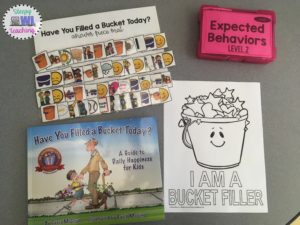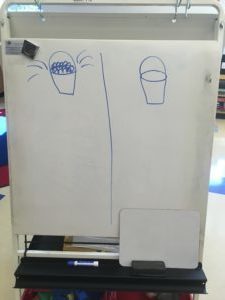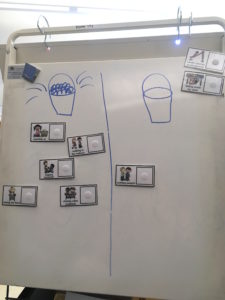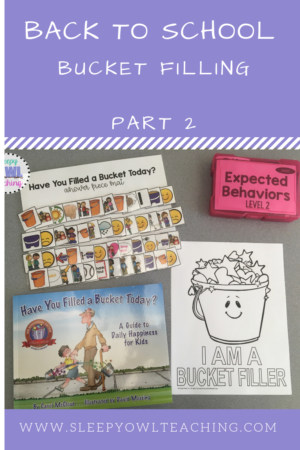Hello all!
Welcome back! A few weeks ago in this post, I talked about using the book Have You Filled a Bucket Today? to teach kindness. As a refresher, it talks about how everyone has an invisible bucket they carry around which holds our good thoughts and feelings. We can fill others’ buckets by doing kind acts or we can dip into their bucket by being unkind. Being unkind dips into our own buckets as well but on the flip side, filling others’ buckets fills our own too! The book can be found here:
In the previous post, mentioned I was going to attempt reading this book with my students and see how it went. Well, we’ve completed the activity, and, overall I think it had it’s shares of ups and downs.
The first thing I did was prep my materials before the lesson. I made the book with Mrs. D’s adapted pieces. I also used the Expected Behavior task cards from Especially Education. We already had these on hand and they seemed like good representations of bucket and non-bucket filling activities. I used our whiteboard easel and split it into two sections. One had a (fabulously drawn thankyouverymuch) empty bucket and one had an (equally artistic) filled bucket.


To start I had all the students and some assistants sit around our table. I introduced the book and began to read. This book is usually a pretty quick read, but stopping on each page to answer the questions made it much longer. I liked taking the time to reinforce the comprehension of the story, but I ended up skipping some questions to speed the story along. Some of my students hung in there, but I definitely lost a few students’ interests about halfway in. I even had one student fall asleep on page 3 and sleep through the whole story (it was the second day of school so I’ll give him a break).
Once we finished reading the book we transitioned to the activity. I brought out the task cards which most students were already familiar with. I went around the table and had each student (except my snoozing friend) choose a card and place it on whichever side of the whiteboard it belonged. In other years, I may print out pictures of more specific kindness acts, but in the interest of low prep, the behavior cards worked well. The students seemed to enjoy the movement break of going up to the whiteboard but I quickly realized this was about the limit of their attention. We only made it through a few cards. I had printed out a bucket filling coloring page to close out the lesson but that fell by the wayside.

Overall, I think my students did fairly well. The reading piece was a little too long for these particular students but the activity went well. The concept seemed to resonate with them. I was worried it might be too abstract, but they were able to show me they understood the concept of bucket filling. If I were to do this lesson again, I would spread it out over multiple days. The first day I would just read straight through the story. Day two would be re-reading the story with the adapted pieces. Hopefully, having heard it once already, the adapted piece activity would take less time. Day three would involve reviewing the story and doing the sorting activity. I think spread over multiple days, this lesson would have much more success.
Since thae lesson, we’ve been trying to use the phrases “bucket filling” and “bucket dipping” throughout the day. I know that one of the general education classes that my students are included in also read the book and did a lesson so I am happy that other teachers and students are using this same language as well so my students have consistency throughout their day.
What do you do to teach kindness? Do you have any lessons that went better or worse than you were expecting?
Happy bucket filling,
![]()
*Some of the links in this post are affiliate links. This means if you click on the link and purchase the item, I will receive an affiliate commission at no extra cost to you. All opinions remain my own, and I only link to products I use and recommend.

